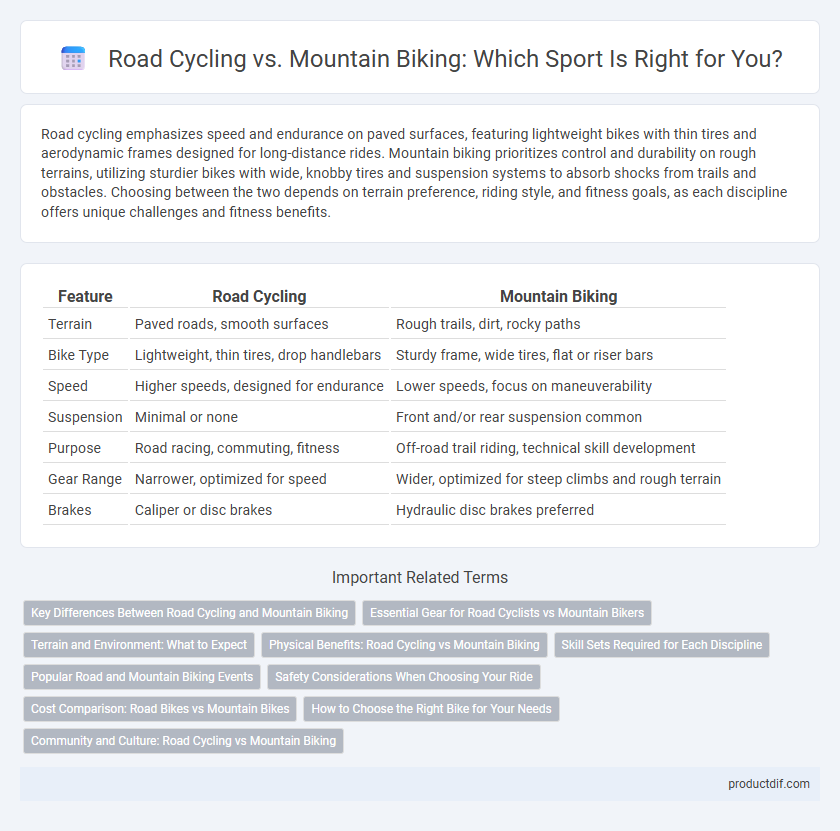Road cycling emphasizes speed and endurance on paved surfaces, featuring lightweight bikes with thin tires and aerodynamic frames designed for long-distance rides. Mountain biking prioritizes control and durability on rough terrains, utilizing sturdier bikes with wide, knobby tires and suspension systems to absorb shocks from trails and obstacles. Choosing between the two depends on terrain preference, riding style, and fitness goals, as each discipline offers unique challenges and fitness benefits.
Table of Comparison
| Feature | Road Cycling | Mountain Biking |
|---|---|---|
| Terrain | Paved roads, smooth surfaces | Rough trails, dirt, rocky paths |
| Bike Type | Lightweight, thin tires, drop handlebars | Sturdy frame, wide tires, flat or riser bars |
| Speed | Higher speeds, designed for endurance | Lower speeds, focus on maneuverability |
| Suspension | Minimal or none | Front and/or rear suspension common |
| Purpose | Road racing, commuting, fitness | Off-road trail riding, technical skill development |
| Gear Range | Narrower, optimized for speed | Wider, optimized for steep climbs and rough terrain |
| Brakes | Caliper or disc brakes | Hydraulic disc brakes preferred |
Key Differences Between Road Cycling and Mountain Biking
Road cycling emphasizes speed and endurance on paved surfaces using lightweight, aerodynamic bikes with narrow tires, while mountain biking prioritizes durability and control over rough, off-road terrain with bikes featuring suspension systems and wider, knobby tires. Road bikes typically have a more aggressive riding position for efficiency, whereas mountain bikes offer a more upright stance to enhance maneuverability and balance on trails. Gear ratios differ significantly, with mountain bikes featuring lower gears to tackle steep climbs and technical obstacles compared to the higher gearing optimized for maintaining cadence on flat, smooth roads in road cycling.
Essential Gear for Road Cyclists vs Mountain Bikers
Essential gear for road cyclists includes lightweight road bikes with thin tires, aerodynamic helmets, and padded cycling shorts designed for speed and long-distance comfort. Mountain bikers require robust bicycles with wider, knobby tires, full-face helmets, protective gloves, and durable knee and elbow pads to navigate rough, technical trails. Hydration packs and multi-tool kits are crucial for both, but terrain-specific equipment significantly impacts performance and safety in each cycling discipline.
Terrain and Environment: What to Expect
Road cycling primarily takes place on paved surfaces such as highways, city streets, and smooth country roads, offering a faster and more predictable riding experience. Mountain biking involves rugged trails, dirt paths, rocky terrain, and steep inclines, requiring durable bikes and advanced handling skills. Riders should prepare for varying weather conditions and natural obstacles like roots, rocks, and mud when mountain biking, while road cycling generally faces less environmental unpredictability.
Physical Benefits: Road Cycling vs Mountain Biking
Road cycling primarily enhances cardiovascular endurance and leg muscle tone through sustained, steady efforts on paved surfaces, promoting efficient oxygen use and stamina. Mountain biking engages a broader range of muscle groups, including core and upper body muscles, due to varied terrain and technical challenges, which improves balance, coordination, and strength. Both disciplines offer significant physical benefits; road cycling excels in aerobic conditioning while mountain biking enhances muscle versatility and overall functional fitness.
Skill Sets Required for Each Discipline
Road cycling demands strong endurance, efficient pacing, and advanced group riding skills to navigate high-speed pelotons and maintain sustained power output. Mountain biking requires superior bike handling abilities, technical maneuvering over rough terrain, and quick reflexes to tackle obstacles like rocks, roots, and steep descents. Both disciplines emphasize cardiovascular fitness but develop distinct skill sets tailored to their specific environmental challenges and competitive formats.
Popular Road and Mountain Biking Events
The Tour de France stands as the pinnacle of road cycling events, attracting elite cyclists worldwide and showcasing grueling endurance across diverse terrains. In contrast, the UCI Mountain Bike World Championships highlight technical skills and rugged off-road courses, challenging riders with steep climbs and rapid descents. Both events draw large global audiences and significantly influence the popularity and development of their respective disciplines.
Safety Considerations When Choosing Your Ride
Road cycling demands high visibility gear and helmets designed to protect against high-speed impacts, while mountain biking requires robust protective equipment like full-face helmets and body armor to guard against falls on uneven terrain. Proper tire selection and bike fit are crucial for stability and control in both disciplines, directly influencing rider safety. Awareness of environmental hazards, such as traffic on roads or loose rocks on trails, should guide protective measures and route planning for both sports.
Cost Comparison: Road Bikes vs Mountain Bikes
Road bikes typically cost between $800 and $5,000, emphasizing lightweight frames and aerodynamic components optimized for speed on paved surfaces. Mountain bikes range from $600 to $4,500, featuring durable frames, suspension systems, and wider tires designed for rugged off-road trails. High-end road bikes often include advanced carbon fiber materials and electronic shifting, while mountain bikes invest in enhanced suspension technologies and robust braking systems, influencing their respective price points.
How to Choose the Right Bike for Your Needs
Selecting the right bike involves evaluating terrain preferences, with road cycling favoring lightweight frames and thin tires for speed on paved surfaces, while mountain biking requires durable frames and wider, knobby tires for rough, uneven trails. Consider suspension types, as hardtail mountain bikes offer efficiency and lower cost, whereas full-suspension models provide enhanced control and comfort over technical terrain. Prioritize factors like riding frequency, budget, and intended use to ensure optimal performance, comfort, and longevity in your chosen cycling discipline.
Community and Culture: Road Cycling vs Mountain Biking
Road cycling communities emphasize group rides, competitive events, and a shared passion for endurance and speed, often fostering a culture of discipline and performance. Mountain biking culture values adventure, trail exploration, and environmental stewardship, creating a close-knit community focused on skill development and outdoor camaraderie. Both sports cultivate strong social bonds but differ in their core values and the riding environments they celebrate.
Road Cycling vs Mountain Biking Infographic

 productdif.com
productdif.com